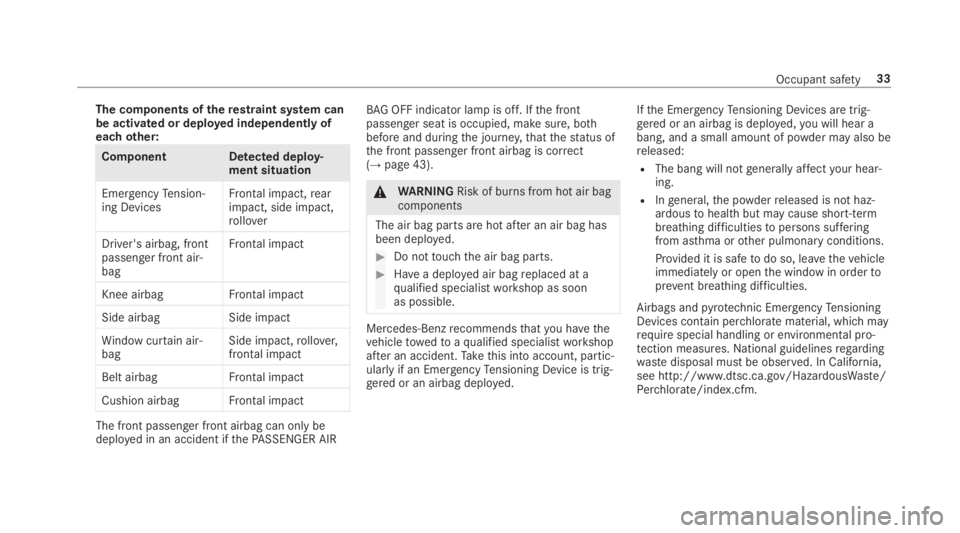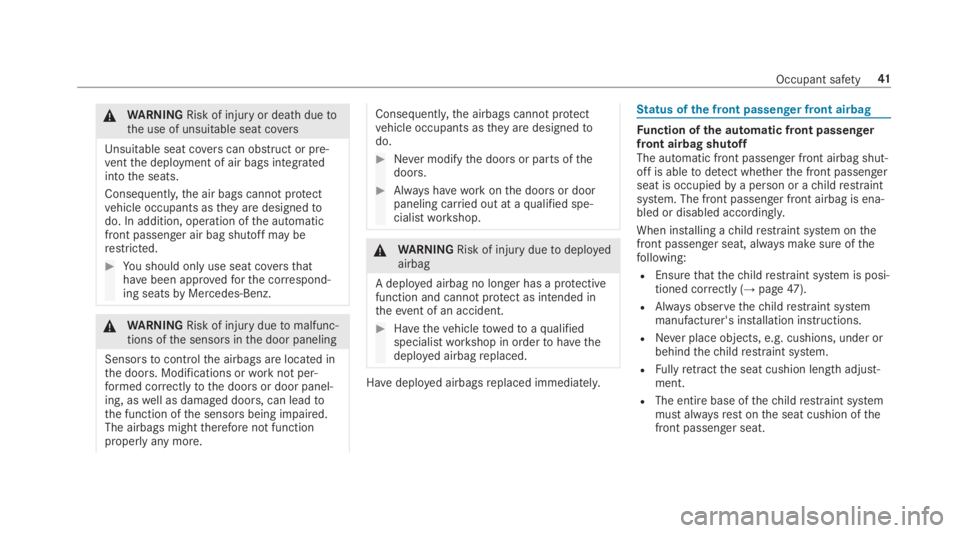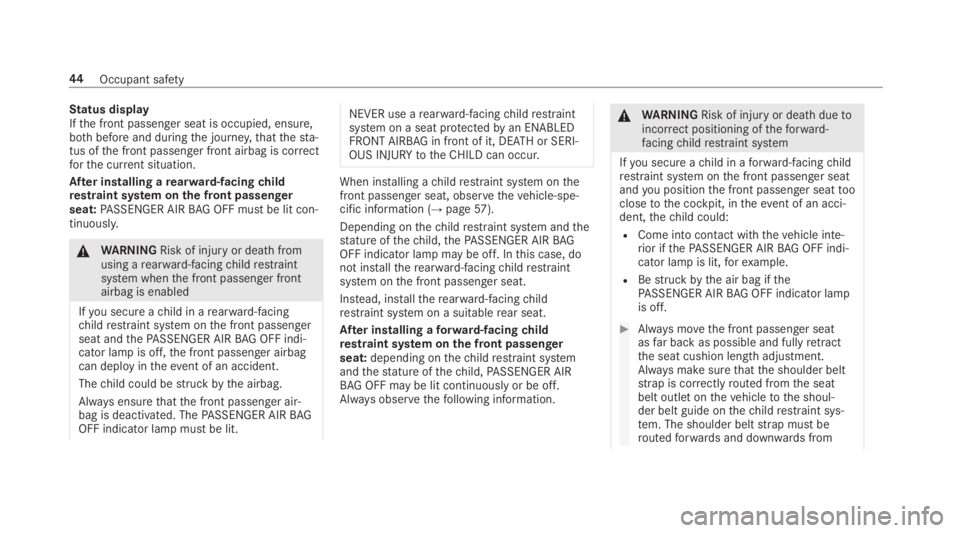2019 MERCEDES-BENZ S CLASS airbag off
[x] Cancel search: airbag offPage 28 of 578

QR codeforrescue card
The QR code is secured inthe fuelfillerflap andonthe opposite side onthe B-pillar. Intheeventof an accident,rescue services can usethe QRcodetoquicklyfindthe appropriaterescue cardforyourvehicle. The currentrescue card con‐tainsthe most important information aboutyourvehicle in a compactform, e.g.therouting oftheelectric lines.
Further information can be obtained at http://www.mercedes-benz.de/qr-code.
Datastorage
Electronic control units
Electronic control units are installed inyourvehi‐cle. Some ofthese are necessaryforthe safeoperation ofyourvehicle, while some assistyouwhen driving (driver assistance systems). Inaddition,yourvehicle provides comfortandentertainment functions, which are also madepossiblebyelectronic control units.
Electronic control units contain datamemorieswhichcantemporarily or permanentlystore
technical information aboutthevehicle's operat‐ingstate, component loads, maintenancerequirements andtechnicalevents or malfunc‐tions.
Ingeneral,this information documentsthestateof a component part, a module, a system orthesurroundings such as:
Roperatingstatus of system components (e.g.fill levels, batterystatus, tire pressure)
Rstatus messages concerningthevehicle orits individual components (e.g. number ofwheelrevolutions/speed, longitudinal accel‐eration, lateral acceleration, display offas‐tened seat belts)
Rmalfunctions orfaults in important systemcomponents (e.g. lights, brakes)
Rinformation onevents leadingtovehicledamage
Rsystemreactions in special driving situations(e.g. airbag deployment, intervention ofsta‐bility control systems)
Rambient conditions (e.g.temperature,rainsensor)
In additiontoprovidingthe actual control unitfunction,this data assiststhe manufacturer indetecting andrectifying malfunctions and opti‐mizingvehicle functions. The majority ofthisdata istemporary and is only processed inthevehicle itself. Only a small portion ofthe data isstored intheevent or malfunction memory.
Whenyourvehicle is serviced,technical datafromthevehicle can beread outbyservice net‐workemployees (e.g.workshops, manufactur‐ers) orthird parties (e.g. breakdown services).Services includerepair services, maintenanceprocesses,warranty claims andquality assur‐ance measures,forexample. Theread out is per‐formed viathe legally prescribed portforthediagnostics connection inthevehicle. Therespective service network locations orthirdparties collect, process and usethe data. Theydocumenttechnicalstatuses ofthevehicle,assist infinding malfunctions and improvingquality and are transmittedtothe manufacturer,if necessary.Furthermore,the manufacturer issubjecttoproduct liability.Forthis,the manu‐facturerrequirestechnical datafromvehicles.
26General notes
Page 35 of 578

The components oftherestraint system canbe activated or deployed independently ofeachother:
Component Detected deploy‐ment situation
EmergencyTension‐ing DevicesFrontal impact,rearimpact, side impact,rollover
Driver's airbag, frontpassenger front air‐bag
Frontal impact
Knee airbagFrontal impact
Side airbagSide impact
Window curtain air‐bagSide impact,rollover,frontal impact
Belt airbagFrontal impact
Cushion airbagFrontal impact
The front passenger front airbag can only bedeployed in an accident ifthePASSENGER AIR
BAG OFF indicator lamp is off. Ifthe frontpassenger seat is occupied, make sure, bothbefore and duringthe journey,thatthestatus ofthe front passenger front airbag is correct(→page43).
&WARNINGRisk of burns from hot air bagcomponents
The air bag parts are hot after an air bag hasbeen deployed.
#Do nottouchthe air bag parts.
#Havea deployed air bagreplaced at aqualified specialistworkshop as soonas possible.
Mercedes-Benzrecommendsthatyou havethevehicletowedtoaqualified specialistworkshopafter an accident.Takethis into account, partic‐ularly if an EmergencyTensioning Device is trig‐gered or an airbag deployed.
Ifthe EmergencyTensioning Devices are trig‐gered or an airbag is deployed,you will hear abang, and a small amount of powder may also bereleased:
RThe bang will notgenerally affectyour hear‐ing.
RIngeneral,the powderreleased is not haz‐ardoustohealth but may cause short-termbreathing difficultiestopersons sufferingfrom asthma orother pulmonary conditions.
Provided it is safetodo so, leavethevehicleimmediately or openthe window in ordertoprevent breathing difficulties.
Airbags andpyrotechnic EmergencyTensioningDevices contain perchlorate material, which mayrequire special handling or environmental pro‐tection measures.National guidelinesregardingwaste disposal must be observed. In California,see http://www.dtsc.ca.gov/HazardousWaste/Perchlorate/index.cfm.
Occupant safety33
Page 39 of 578

Fastening and adjustingthe seat belts
Ifthe seat belt is pulledquickly or sharply,theseat beltretractor locks. The seat beltstrap can‐not be pulled out any further.
#Always engage seat belttongue2oftheseat belt into seat belt buckle1ofthe cor‐responding seat.
#Press and holdthe seat belt outletreleaseand slide seat belt outlet3intothe desiredposition.
#Let go ofthe seat belt outletrelease andensurethat seat belt outlet3locksintoposition.
Vehicles with automatic front passengerfront airbag shutoff:
*NOTEDeployment ofthe EmergencyTensioning Device and side air bag whenthe front passenger seat is unoccupied
Ifthe seat belttongue is engaged inthe seatbelt buckle ofthe unoccupied frontpassenger seat,the EmergencyTensioningDevice andthe side air bag may also deployintheevent of an accident along withothersystems.
#Only one person should use each seatbelt at any one time.
Vehicles without automatic front passengerfront airbag shutoff:
*NOTEDeployment ofthe EmergencyTensioning Device whenthe front-passenger seat is unoccupied
Ifthe seat belttongue is engaged inthe seatbelt buckle ofthe unoccupied front-passenger seat,the EmergencyTensioningDevice may also deployintheevent of anaccident along withother systems.
#Only one person should use each seatbelt at any one time.
Seat belt adjustment function
Vehicles with PRE-SAFE®:Ifthe front seat beltis not pulled tight acrossyour body,the seat beltadjustment may automatically apply a certaintighteningforce. Do not holdthe seat belt tightlywhile it is adjusting.
You can activate and deactivatethe seat beltadjustment function usingthe multimedia sys‐tem (→page 38).
Occupant safety37
Page 41 of 578

Potential protection from each airbag:
AirbagPotential protectionfor…
Knee airbag Thigh, knee and lower leg
Driver's airbag,front passengerfront airbag
Head andribcage
Window curtainairbagHead
Side impact air‐bagRibcage, also pelvisforfront seat occupants
The front passenger front airbag can only bedeployed in an accident ifthePASSENGER AIRBAG OFF indicator lamp is off. Ifthe frontpassenger seat is occupied, make sure, bothbefore and duringthe journey,thatthestatus ofthe front passenger front airbag is correct(→page43).
*NOTEImportant pointstoremember ifthe front passenger seat is unoccupied
In an accident,the components oftherestraint system may deploy unnecessarilyonthe front passenger side if:
RThere are heavy objects onthe frontpassenger seat.
RThe seat belttongue is engaged intheseat belt buckle ofthe front passengerseat andthe front passenger seat isunoccupied.
#Stowobjects in a suitable place.
#Only one person should use each seatbelt at any one time.
Cushionbag intherecliningrear seatIfthe seat backrest inclination is significant,thecushionbag provides additional occupant protec‐tion intheevent of a frontal impact. When acti‐vated,the cushionbag deploysunderthe seatcushion. This helps preventthevehicle occupantfrom slipping offthe seat cushion.
Ifyou install achildrestraint system ontherecliningrear seat, always observethe additionalnotes (→page 48).
Protectionbythe airbags
Depending onthe accident situation, an airbagmay supplementthe protection offeredbya cor‐rectlyfastened seat belt.
&WARNINGRisk of injuryor death duetoincorrect seat position
Ifyou deviate fromthe correct seat position,the air bag cannotperformits intended pro‐tective function and deployment mayevencause further injuries.
Toavoid hazardous situations, always makesurethat allvehicle occupants:
RHavetheir seat beltfastened correctly,including pregnantwomen.
RAre seated properlyandthat distancetothe air bags is as largeas possible.
RObservethefollowing information.
Occupant safety39
Page 43 of 578

&WARNINGRisk of injuryor death duetothe use of unsuitable seat covers
Unsuitable seat coverscan obstruct or pre‐ventthe deployment of air bags integratedintothe seats.
Consequently,the air bags cannotprotectvehicle occupants astheyare designedtodo. In addition, operation ofthe automaticfront passenger air bag shutoff may berestricted.
#You should onlyuse seat coversthathavebeen approvedforthe correspond‐ing seatsbyMercedes-Benz.
&WARNINGRisk of injuryduetomalfunc‐tions ofthe sensors inthe door paneling
Sensorstocontrolthe airbags are located inthe doors. Modifications orworknot per‐formed correctlytothe doors or door panel‐ing, aswell as damaged doors, can leadtothe function ofthe sensors being impaired.The airbags mighttherefore not functionproperlyany more.
Consequently,the airbags cannotprotectvehicle occupants astheyare designedtodo.
#Never modifythe doors or parts ofthedoors.
#Always haveworkonthe doors or doorpaneling carried out at aqualified spe‐cialistworkshop.
&WARNINGRisk of injuryduetodeployedairbag
A deployed airbag no longer has a protectivefunction and cannotprotect as intended intheevent of an accident.
#Havethevehicletowedtoaqualifiedspecialistworkshop in ordertohavethedeployed airbagreplaced.
Havedeployed airbagsreplaced immediately.
Status ofthe front passenger front airbag
Function ofthe automatic front passengerfront airbag shutoffThe automatic front passenger front airbag shut‐off is abletodetect whetherthe front passengerseat is occupiedbya person or achildrestraintsystem. The front passenger front airbag is ena‐bled or disabled accordingly.
When installing achildrestraint system onthefront passenger seat, always make sure ofthefollowing:
REnsurethatthechildrestraint system is posi‐tioned correctly (→page47).
RAlways observethechildrestraint systemmanufacturer's installation instructions.
RNever place objects, e.g. cushions, under orbehindthechildrestraint system.
RFullyretractthe seat cushion length adjust‐ment.
RThe entire base ofthechildrestraint systemmust alwaysrestonthe seat cushion ofthefront passenger seat.
Occupant safety41
Page 44 of 578

RThe backrest oftheforward-facingchildrestraint system must lie asflat as possibleagainstthe backrest ofthe front passengerseat.
RThechildrestraint system must nottouchtheroof or be put understrainbythe headrestraints.Adjustthe seat backrest inclina‐tion andthe headrestraint setting accord‐ingly.
&WARNINGRisk of injuryor death duetoobjects betweenthe sitting surface andthechildrestraint system
Objects betweenthe sitting surface andthechildrestraint system could affectthe func‐tion ofthe automatic front passenger airbagshutoff.
This couldresult inthe front passenger air‐bag not functioning as intended during anaccident.
#Do not place any objects betweenthesitting surface andthechildrestraintsystem.
#The entire base ofthechildrestraintsystem must alwaysrestonthe sittingsurface ofthe front passenger seat.
#The backrest oftheforward-facingchildrestraint system must, asfar as possi‐ble, beresting onthe seat backrest ofthe front passenger seat.
#Always comply withthechildrestraintsystem manufacturer's installationinstructions.
A person onthe front passenger seat mustobservethefollowing information:
RFasten seat belts correctly (→page34).
RSit in an almost upright seat position withtheir back againstthe seat backrest.
RSit withtheirfeetresting onthefloor, if pos‐sible.
The front passenger front airbag mayotherwisebe disabledbymistake,forexample inthefol‐lowing situations:
RThe front passenger transferstheirweightbysupportingthemselves on avehicle armrest.
RThe front passenger sits in such awaythattheirweight israised fromthe sitting sur‐face.
&WARNINGRisk of injuryor death duetodeactivated front passenger airbag
IfthePASSENGER AIRBAG OFF indicatorlamp is lit,the front passenger airbag is disa‐bled. It will not be deployed intheevent ofan accident and cannotperformits intendedprotective function.
A person inthe front passenger seat couldthen,forexample, come into contact withthevehicle interior, especially ifthe person issittingtoo closetothe cockpit.
Ifthe front passenger seat is occupied,always ensurethat:
RThe classification ofthe person inthefront passenger seat is correct andthefront passenger airbag is enabled or disa‐bled in accordance withthe person inthefront passenger seat.
42Occupant safety
Page 45 of 578

RThe front passenger seat has been movedasfar back as possible.
RThe person is seated correctly.
#Ensure, bothbefore and duringthe jour‐ney,thatthestatus ofthe frontpassenger airbag is correct.
Ifthe front passenger seat is occupied,the clas‐sification ofthe person orchildrestraint systemonthe front passenger seattakes place afterthefront passenger front airbag shutoff self-test.ThePASSENGER AIRBAG indicator lamps dis‐playthestatus ofthe front passenger front air‐bag.
Always observethe notes onthe function ofthePASSENGER AIRBAG indicator lamps(→page 43).
Function ofthePASSENGER AIRBAG indica‐tor lamps
Self-testof automatic front passenger frontairbag shutoffWhenthe ignition is switched on, a self-test isperformed during whichthe twoPASSENGERAIRBAG ON and OFF indicator lamps light upsimultaneously.
Thestatus ofthe front passenger front airbag isdisplayed afterthe self-test:
RPASSENGER AIRBAG ON lights upfor60 seconds, subsequently bothindicatorlamps are off (PASSENGER AIRBAG ON andOFF):the front passenger front airbag is abletodeploy intheevent of an accident.
RPASSENGER AIRBAG OFF lights up continu‐ously:the front passenger front airbag is dis‐abled. It willthen not be deployed intheevent of an accident.
IfthePASSENGER AIRBAG ON indicator lamp isoff, onlythePASSENGER AIRBAG OFF indicatorlamp shows thestatus ofthe front passengerfront airbag. ThePASSENGER AIRBAG OFF indi‐cator lamp may be lit continuously or be off.
IfthePASSENGER AIRBAG OFF indicator lampandthe�urestraint systemwarning lamplight up simultaneously,the front passenger seatmay not be used. Also inthis case, do not installachildrestraint system onthe front passengerseat. Haveautomatic front passenger front air‐bag shutoffchecked andrepaired immediately ataqualified specialistworkshop.
Occupant safety43
Page 46 of 578

Status displayIfthe front passenger seat is occupied, ensure,bothbefore and duringthe journey,thatthesta‐tus ofthe front passenger front airbag is correctforthe current situation.
After installing arearward-facingchildrestraint system onthe front passengerseat:PASSENGER AIRBAG OFF must be lit con‐tinuously.
&WARNINGRisk of injuryor death fromusing arearward-facingchildrestraintsystem whenthe front passenger frontairbag is enabled
Ifyou secure achild in arearward-facingchildrestraint system onthe front passengerseat andthePASSENGER AIRBAG OFF indi‐cator lamp is off,the front passenger airbagcan deploy intheevent of an accident.
Thechild could bestruckbythe airbag.
Always ensurethatthe front passenger air‐bag is deactivated. ThePASSENGER AIRBAGOFF indicator lamp must be lit.
NEVER use arearward-facingchildrestraintsystem on a seat protectedbyan ENABLEDFRONT AIRBAGin front of it, DEATH or SERI‐OUS INJURYtotheCHILD can occur.
When installing achildrestraint system onthefront passenger seat, observethevehicle-spe‐cific information (→page57).
Depending onthechildrestraint system andthestature ofthechild,thePASSENGER AIRBAGOFF indicator lamp may be off. Inthis case, donot installtherearward-facingchildrestraintsystem onthe front passenger seat.
Instead, installtherearward-facingchildrestraint system on a suitablerear seat.
After installing aforward-facingchildrestraint system onthe front passengerseat:depending onthechildrestraint systemandthestature ofthechild,PASSENGER AIRBAG OFF may be lit continuously or be off.Always observethefollowing information.
&WARNINGRisk of injuryor death duetoincorrect positioning oftheforward-facingchildrestraint system
Ifyou secure achild in aforward-facingchildrestraint system onthe front passenger seatandyou positionthe front passenger seattooclosetothe cockpit, intheevent of an acci‐dent,thechild could:
RCome into contact with thevehicle inte‐rior ifthePASSENGER AIRBAG OFF indi‐cator lamp is lit,forexample.
RBestruckbythe air bag ifthePASSENGER AIRBAG OFF indicator lampis off.
#Always movethe front passenger seatasfar back as possible and fullyretractthe seat cushion length adjustment.Always make surethatthe shoulder beltstrap is correctlyrouted fromthe seatbelt outlet onthevehicletothe shoul‐der belt guide onthechildrestraint sys‐tem. The shoulder beltstrap must beroutedforwards and downwards from
44Occupant safety